The intake manifold is a critical engine component that regulates the flow of air and fuel into the cylinders. It is responsible for ensuring that each cylinder receives its proper share of air and fuel, so it’s important to make sure your intake manifold is in good condition.
But did you know that having oil in intake manifold can cause all sorts of serious problems? Many people don’t, but it’s important to be aware of the issue so that you can take steps to prevent it from happening to your vehicle.
In this blog post, we’ll discuss what causes oil in intake manifold and how you can go about fixing the problem. We’ll also provide some tips for keeping your car running smoothly.
What's in this post?
What causes oil in intake manifold?
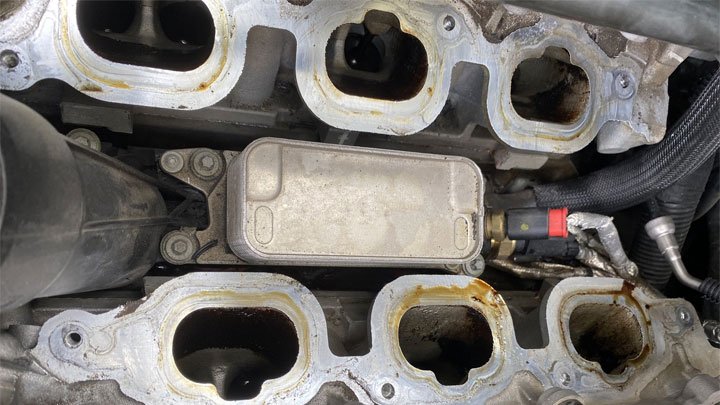
There are many reasons why oil might end up in your car’s intake manifold. Here are the common causes of oil in the intake manifold:
- Leaking valve cover gasket
- Ineffective fuel injectors
- Failed piston ring
- Camshafts worn out
- Clogged oil passage
- Dirty air filters
- Faulty PCV valve
Now we will go through the details of each cause. Keep reading!
Leaking valve cover gasket
The most common cause of oil in the intake manifold is a leaking valve cover gasket.
When this gasket fails, it allows oil to seep into the engine where it can eventually make its way into the intake manifold.
While many people think that this oil will simply burn off once the engine is started, it can actually cause a number of problems.
First, it can lead to a build-up of carbon deposits on the valves and pistons, which can cause the engine to run less efficiently. Additionally, oil in the intake manifold can cause misfires and increased fuel consumption.
As a result, it is important to have any leaks fixed as soon as possible. Otherwise, you could be faced with significant engine damage down the line.
Ineffective fuel injectors
If your car has fuel injectors that are not working properly, they can allow oil to enter the combustion chamber and mix with the fuel.
This can lead to a decrease in engine performance and efficiency, and can also cause deposits to build up on the valves and pistons. In some cases, it can also cause the engine to “knock” or “ping.”
If you notice any of these symptoms, it is important to have your car inspected by a qualified mechanic as soon as possible. Left unchecked, oil in the combustion chamber can cause serious damage to your engine.
Failed piston ring
Another possible cause of oil in the intake manifold is a failed piston ring.
If a piston ring is damaged, it can allow oil to leak into the cylinder and be drawn into the intake manifold when the engine is running.
This can happen if the piston rings are worn out, or if they have been damaged by debris in the engine. In either case, replacing the piston rings is the only way to fix the problem.
Piston rings are relatively inexpensive, and they are easy to replace. However, if you do not have experience with engine repairs, it is best to take your car to a mechanic and have them handle the repair.
Camshafts that are worn out
A camshaft is a shaft to which a cam is attached. The camshaft is used to open and close the valves in an internal combustion engine.
The camshaft is driven by the crankshaft, and the two components work together to convert the reciprocating motion of the pistons into the rotating motion of the crankshaft.
Over time, the camshaft can become worn out, causing oil to enter the intake manifold. If the camshaft is worn, it can create a gap between the valve and the piston where oil can seep through. In some cases, this can result in engine failure.
Therefore, it is important to regularly check the condition of your camshaft and replace it if necessary.
Clogged oil passage
Another common issue is a clogged oil passage.
When oil becomes trapped in the engine, it can slowly begin to restrict the oil flow. In some cases, this can cause the oil to back up into the intake manifold.
This eventually leads to a buildup of oil on the cylinder walls and pistons, which can lead to excessive engine wear.
In addition, a clogged oil passage can cause the engine to overheat, as the oil is unable to flow freely and dissipate heat effectively.
As such, it is important to have any clogged oil passages cleaned out as soon as possible to avoid serious engine damage.
Dirty air filters
When an air filter becomes clogged, it can restrict air flow to the engine. This can cause the engine to run lean, which can lead to oil being pulled into the intake manifold.
Additionally, a dirty air filter can allow unfiltered air to enter the engine and mix with the oil. This can cause the oil to become contaminated and lead to engine problems.
For these reasons, it is important to regularly check and replace your air filter to help prevent oil from entering the intake manifold.
Faulty PCV valve
Oil build-up in the intake manifold is usually caused by a faulty PCV valve.
This valve is responsible for regulating the pressure inside the engine, and if it isn’t working properly, it can allow oil to escape into the intake manifold.
In most cases, a faulty PCV valve will need to be replaced in order to fix the problem. However, if the issue is caught early, it may be possible to clean the intake manifold and repair the PCV valve.
Either way, it’s important to have a qualified mechanic take a look at your engine if you suspect that there may be an issue with the PCV valve.
Oil build-up in the intake manifold can cause serious engine damage if left unchecked, so it’s best to take care of the problem as soon as possible.
How do I know if I have oil in intake manifold?
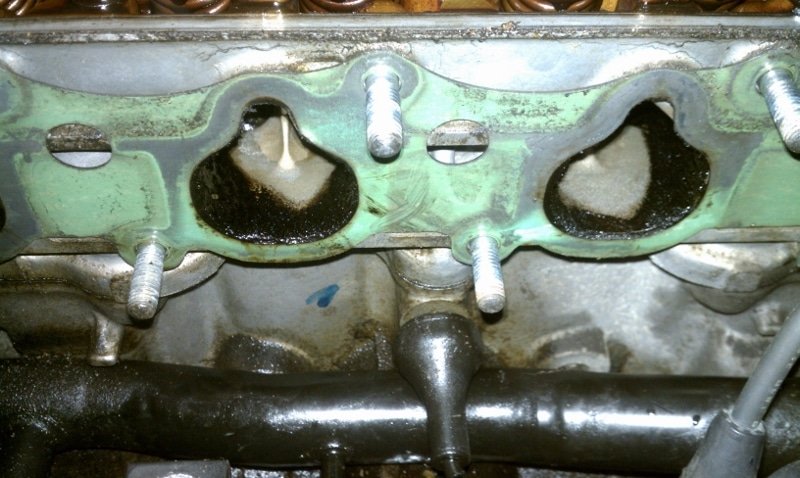
An oil-in-intake manifold issue can cause a variety of symptoms. Here are some of the most common symptoms that you might experience if your car has this issue:
Engine smoke
Oil in the intake manifold can cause the engine to smoke. This can happen for a variety of reasons, but the most common is oil that has leaked past the piston rings and into the crankcase.
When this happens, the oil can then be drawn into the intake manifold by the vacuum created by the engine.
Once in the intake manifold, the oil can then enter the combustion chamber and cause the fuel to ignite prematurely.
This can create a lot of heat and pressure in the engine, which can then cause the engine to smoke.
If oil in the intake manifold is suspected, it is important to have the engine checked as soon as possible to avoid further damage. If you see black smoke, maybe it’s an exhaust leak symptom.
Rough idling
This is because oil can interfere with the air and fuel mixture that is necessary for smooth operation.
When oil enters the intake manifold, it can coat the surfaces of the cylinders and prevent proper combustion.
As a result, the engine will run rough and may stall. In some cases, oil in the intake manifold can also cause engine misfires.
Reduced engine power
When oil enters the engine, it can cause the cylinders to become clogged and the engine to lose power.
This is because the oil can interfere with the air and fuel mixture that is necessary for smooth operation.
The oil can also build up in the intake manifold, causing the engine to run less efficiently.
If you notice that your engine is losing power or running less smoothly, it’s important to have it checked out by a professional. They will be able to determine if oil is the cause of the problem and take steps to fix it.
Decreased fuel efficiency
First, oil can build up on the intake valves, causing them to stick and rendering the engine less efficient.
Additionally, oil can form deposits in the combustion chamber, leading to incomplete combustion and increased fuel consumption.
Finally, oil can coat the spark plugs, making them less effective at igniting the air-fuel mixture and resulting in lower engine power and decreased fuel efficiency.
In order to maintain optimum engine performance, it is important to periodically check the oil level in the intake manifold and top off as needed.
How to detect the problem
If you think that your car might have an oil-in-intake manifold issue, there are a few things that you can do to check.
Use a car smoke machine
A smoke machine is a tool that can be used to detect leaks in the engine.
To use a smoke machine, the technician will connect it to the intake manifold and turn it on.
If there is an oil leak, the smoke will be drawn into the engine and you’ll be able to see it coming out of the tailpipe.
Use a pressure tester
A pressure tester can be used to check for leaks in the intake manifold.
To use a pressure tester, the technician will connect it to the intake manifold and turn it on.
If there is an oil leak, the pressure will drop and you’ll be able to see it coming out of the tailpipe.
How to fix oil in the intake manifold step by step
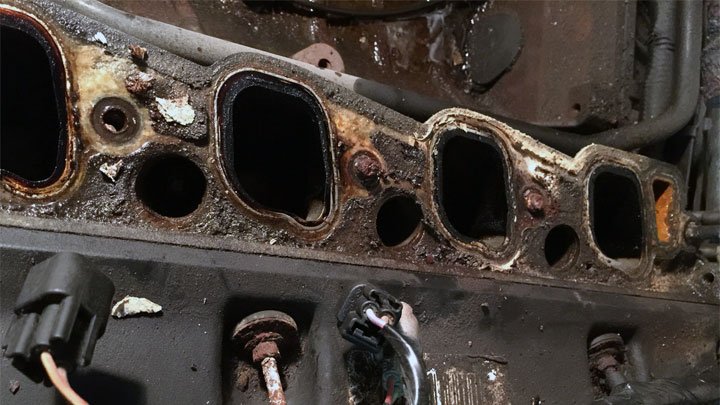
Oil in the intake manifold is not a serious problem, but it can cause some engine damage if left unchecked.
Here are some steps that you can take to fix oil in the intake manifold:
1. Check the oil level in the engine and top off as needed
2. Clean the surfaces of the intake valves with a cloth or brush
3. Inspect the PCV valve and replace it if necessary
4. Change the air filter
5. Inspect the camshaft for wear and replace if necessary
6. Flush the engine to remove any build-up of oil
7. Inspect the oil passages for blockages and clean as needed
8. Replace the piston rings if they are worn or damaged
9. Install new valve seals if they are worn or damaged
10. Have the engine checked by a professional if the problem persists
These steps should help to fix oil in the intake manifold. However, it is important to have the engine checked by a professional to avoid further damage.
How to prevent it from happening again
To prevent oil from entering the intake manifold, it is important to regularly check the oil level in the engine and top off as needed. This will help to ensure that the seals and gaskets are properly lubricated and less likely to leak.
It is also important to change the air filter and inspect the PCV valve on a regular basis. These components can become clogged with oil and debris, which can lead to oil being forced into the intake manifold.
Finally, it is important to have the engine checked by a professional if you notice any changes in performance. An experienced mechanic will be able to identify any potential problems and take steps to prevent further damage.
By taking these simple measures, you can help to keep your engine running smoothly for many years to come.
FAQs about oil in intake manifold
How much does it cost to fix intake manifold leak?
The average cost for replacement is between $500 and $700, with labor costs estimated between $200 and $300 and parts priced between $300 and $400. However, it can be higher because of taxes and car type.
Can oil in intake manifold cause misfire?
Yes. If the oil level in the intake manifold is low, it can cause a misfire. This is because the oil is used to lubricate the seals and gaskets in the engine.
If there is not enough oil, these components can become dry and damaged, which can lead to a misfire.
Can you drive a car with an intake manifold leak?
There is no need to be worried about a small intake manifold leak for the moment.
As long as you don’t have any fluid leaks and your vehicle continues running smoothly, driving with this problem will not cause too much hassle in normal circumstances!
Is oil in intake manifold normal?
Oil in the intake manifold is not necessarily a cause for concern. If there is just a light coating of oil, this is normal and nothing to worry about.
The oil may be coming from the breather tube or from the engine itself.
If the oil is thick or heavy, this could be a sign of a problem with the engine, such as a blown head gasket or damaged piston rings. In this case, it is best to have the engine checked by a mechanic.
How do I know if my intake or head gasket is leaking?
If you notice oil on the outside of your engine, this could be a sign that your head or intake gasket is leaking.
You may also notice white smoke coming from the tailpipe or an overheating engine. If you suspect a leak, it is best to have the engine checked by a mechanic.
Conclusion
The manifold is an essential part of your engine that should be in good condition for your car to run smoothly. When it’s not, you may experience a variety of problems. We hope this article has been helpful in explaining the causes of an oil leak in intake manifold and how to fix it.
If you’re experiencing an oil leak in intake manifold, take your car in for service and have the experts take a look. They’ll be able to recommend the best course of action to get your manifold back in good shape and have you on your way to smoother driving in no time.

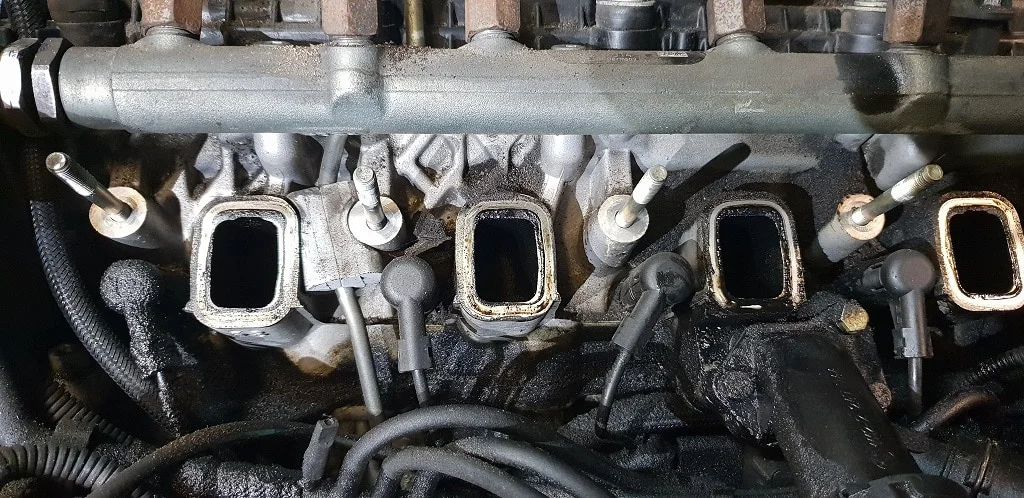

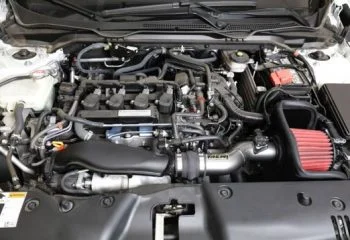

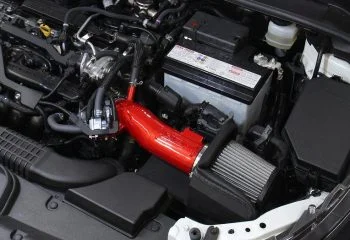
I replaced my valve cover gasket and now the oil has stopped leaking. It was such a relief that it turned out to be an easy problem to fix. Thanks for the article, it was really helpful.
Thank you for your praise. It’s wonderful to know that my work resonated with you.